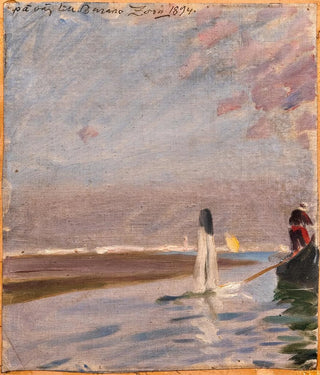Art print En route vers Burano - Anders Zorn | Art print


View from behind

Frame (optional)
En route vers Burano - Anders Zorn – Captivating Introduction
In the vast panorama of art history, certain works manage to transcend their era to capture the essence of a place, a culture, or a moment. "En route vers Burano," created by the Swedish master Anders Zorn, is a perfect example. This canvas, imbued with light and movement, evokes not only the picturesque beauty of the island of Burano but also invites the viewer to immerse themselves in the vibrant atmosphere of the Venetian lagoon. The eye is drawn by the shimmering nuances of the sea and colorful houses, while the human figures, dressed in traditional costumes, seem to live a poetic daily scene. Zorn, through this work, offers us a visual journey that goes beyond the simple frame of painting.
Style and uniqueness of the work
The work "En route vers Burano" stands out for its masterful use of color and light. Zorn, recognized for his ability to capture reflections and play of light, succeeds here in creating an almost tangible atmosphere. The vibrant hues of the facades of the houses blend harmoniously with the reflections in the water, while the sky, in a dazzling blue, appears to merge into the horizon. The dynamic composition, where the figures are in motion, gives the scene a rare vitality. Every detail, from the draping of clothing to the expressions of the figures, demonstrates meticulousness and sensitivity that characterize Zorn's art. In sum, this work is a celebration of life and beauty, offering a window into a world where everyday life transforms into art.
The artist and his influence
Anders Zorn, born in 1860 in Sweden, is one of the most influential artists of his time. His artistic training, combined with his travels across Europe and beyond, allowed him to develop a unique style that merges impressionist influences with refined portrait techniques. Zorn was able to capture the soul of his subjects, whether they are historical figures, friends, or landscapes. His time in Burano, in particular, marked a turning point in his career, enabling him to explore themes of light and

Matte finish

View from behind

Frame (optional)
En route vers Burano - Anders Zorn – Captivating Introduction
In the vast panorama of art history, certain works manage to transcend their era to capture the essence of a place, a culture, or a moment. "En route vers Burano," created by the Swedish master Anders Zorn, is a perfect example. This canvas, imbued with light and movement, evokes not only the picturesque beauty of the island of Burano but also invites the viewer to immerse themselves in the vibrant atmosphere of the Venetian lagoon. The eye is drawn by the shimmering nuances of the sea and colorful houses, while the human figures, dressed in traditional costumes, seem to live a poetic daily scene. Zorn, through this work, offers us a visual journey that goes beyond the simple frame of painting.
Style and uniqueness of the work
The work "En route vers Burano" stands out for its masterful use of color and light. Zorn, recognized for his ability to capture reflections and play of light, succeeds here in creating an almost tangible atmosphere. The vibrant hues of the facades of the houses blend harmoniously with the reflections in the water, while the sky, in a dazzling blue, appears to merge into the horizon. The dynamic composition, where the figures are in motion, gives the scene a rare vitality. Every detail, from the draping of clothing to the expressions of the figures, demonstrates meticulousness and sensitivity that characterize Zorn's art. In sum, this work is a celebration of life and beauty, offering a window into a world where everyday life transforms into art.
The artist and his influence
Anders Zorn, born in 1860 in Sweden, is one of the most influential artists of his time. His artistic training, combined with his travels across Europe and beyond, allowed him to develop a unique style that merges impressionist influences with refined portrait techniques. Zorn was able to capture the soul of his subjects, whether they are historical figures, friends, or landscapes. His time in Burano, in particular, marked a turning point in his career, enabling him to explore themes of light and
12,34 €






